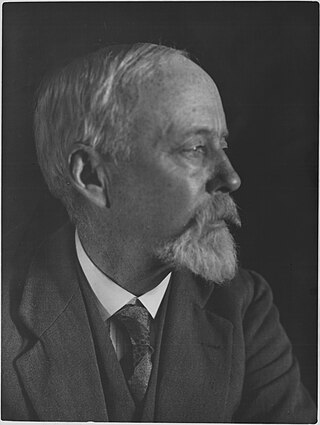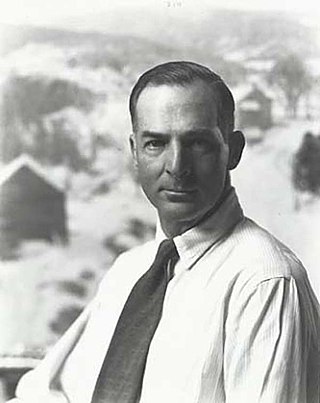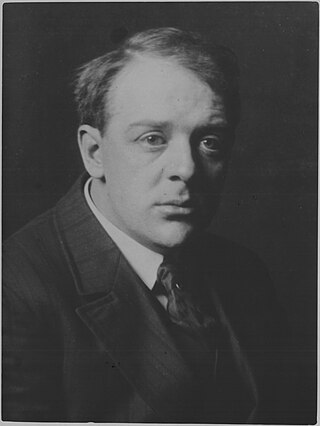
Impressionism was a 19th-century art movement characterized by relatively small, thin, yet visible brush strokes, open composition, emphasis on accurate depiction of light in its changing qualities, ordinary subject matter, unusual visual angles, and inclusion of movement as a crucial element of human perception and experience. Impressionism originated with a group of Paris-based artists whose independent exhibitions brought them to prominence during the 1870s and 1880s.

American Impressionism was a style of painting related to European Impressionism and practiced by American artists in the United States from the mid-nineteenth century through the beginning of the twentieth. The style is characterized by loose brushwork and vivid colors with a wide array of subject matters but focusing on landscapes and upper-class domestic life.

James Wilson Morrice was one of the first Canadian landscape painters to be known internationally. In 1891, he moved to Paris, France, where he lived for most of his career. W. Somerset Maugham knew him and had one of his characters say,
...when you've seen his sketches...you can never see Paris in the same way again.

The Oakland Museum of California or OMCA is an interdisciplinary museum dedicated to the art, history, and natural science of California, located adjacent to Oak Street, 10th Street, and 11th Street in Oakland, California. The museum contains more than 1.8 million objects dedicated to "telling the extraordinary story of California."

Maynard Dixon was an American artist. He was known for his paintings, and his body of work focused on the American West. Dixon is considered one of the finest artists having dedicated most of their art to the U.S. Southwestern cultures and landscapes at the end of the 19th-century and the first half of the 20th-century.
William Henry Gerdts Jr. was an American art historian and professor of Art History at the CUNY Graduate Center. Gerdts was the author of over twenty-five books on American art. An expert in American Impressionism, he was also well known for his work on nineteenth-century American still life painting.

Maurice Cullen is considered to be one of the first Impressionist artists in Canada. He is best known for his paintings of snow and his depictions of ice harvest scenes, featuring horse-drawn sleighs traveling across the frozen waters of Quebec during winter.

The terms California Impressionism and California Plein-Air Painting describe the large movement of 20th century California artists who worked out of doors, directly from nature in California, United States. Their work became popular in the San Francisco Bay Area and Southern California in the first three decades after the turn of the 20th century. Considered to be a regional variation on American Impressionism, the California Impressionists are a subset of the California Plein-Air School.
California Tonalism was art movement that existed in California from circa 1890 to 1920. Tonalist are usually intimate works, painted with a limited palette. Tonalist paintings are softly expressive, suggestive rather than detailed, often depicting the landscape at twilight or evening, when there is an absence of contrast. Tonalist paintings could also be figurative, but in them, the figure was usually out of doors or in an interior in a low-key setting with little detail.
The Society of Six was a group of artists who painted outdoors, socialized, and exhibited together in and around Oakland, California in the 1910s and 1920s. They included Selden Connor Gile, August Gay, Maurice Logan, Louis Siegriest, Bernard von Eichman, and William H. Clapp. They were somewhat isolated from the artistic mainstream of the San Francisco Bay Area at the time, and painted in more avant-garde styles than most of their peers, especially after being inspired by modern trends represented in the Panama Pacific International Exposition of 1915.

Allen Butler Talcott was an American landscape painter. After studying art in Paris for three years at Académie Julian, he returned to the United States, becoming one of the first members of the Old Lyme Art Colony in Connecticut. His paintings, usually landscapes depicting the local scenery and often executed en plein air, were generally Barbizon and Tonalist, sometimes incorporating elements of Impressionism. He was especially known and respected for his paintings of trees. After eight summers at Old Lyme, he died there at the age of 41.

Robert Wakeham Pilot was a Canadian artist, who worked mainly in oil on canvas or on panel, and as an etcher and muralist. He is considered to be the last artist in Canada to paint Impressionistically with any authority or significance.
Canadian Impressionism is a subclass of Impressionist art which had its origin in French Impressionism. Guy Wildenstein of the Wildenstein Institute in Paris states in the foreword of A.K. Prakash's Impressionism in Canada: A Journey of Rediscovery that Canadian impressionism consists of "the Canadian artists who gleaned much from the French but, in their improvisations, managed to transmute what they learned into an art reflecting the aesthetic concerns of their compatriots and the times in which they lived and worked". The early Canadian Impressionist painters belong in the "Group of who?" as coined by James Adams of The Globe and Mail.

Harry "Tony" Leith-Ross was a British-American landscape painter and teacher. He taught at the art colonies in Woodstock, New York and Rockport, Maine, and later was part of the art colony in New Hope, Pennsylvania. A precise draftsman and a superb colorist, Leith-Ross is considered one of the Pennsylvania Impressionists.
William Jurian Kaula was an American watercolor painter.
Louis Bassi Siegriest was an American painter. He was a member of the Society of Six.
August Gay whose birth name was Auguste-François Pierre Gay was a French-born American painter and etcher. He was a member of the Society of Six in Oakland, California, and an Impressionist landscape painter.

Albert Henry Robinson, also known as Albert H. Robinson and as A. H. Robinson was a Canadian landscape painter, an invited contributor to the first Group of Seven exhibition in 1920, as well as a founding member of the Beaver Hall Group in 1920 and the Canadian Group of Painters in 1933. He used the rolling rhythm of landscape parallel to the picture plane used by A.Y. Jackson, with whom he often painted on trips to Quebec, but endowed his work with unusual colours – corals, pinks, dark blue. He sought simplified, powerful form

Among the Sierra Nevada, California is an 1868 oil-on-canvas painting by German-American artist Albert Bierstadt which depicts a landscape scene of the Sierra Nevada mountain range in California. Created at his studio in Rome, the painting was exhibited throughout Europe, creating interest in immigration to the United States. Measuring 72 by 120+1⁄8 inches, the painting is a centerpiece of the 19th-century landscape collection at the Smithsonian American Art Museum in Washington, D.C.

Arthur Dominique Rozaire was a Canadian impressionist painter, who painted landscape, and a photographer. His personal form of Impressionism, using broad expressive brushstrokes, evolved from Maurice Cullen, one of his teachers. He changed the spelling of his last name in the paintings he signed due to a misprint in an Art Association of Montreal Spring show catalogue of 1900.














